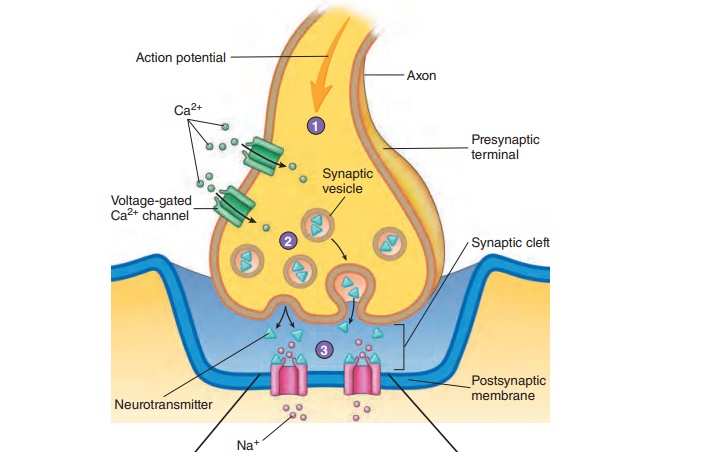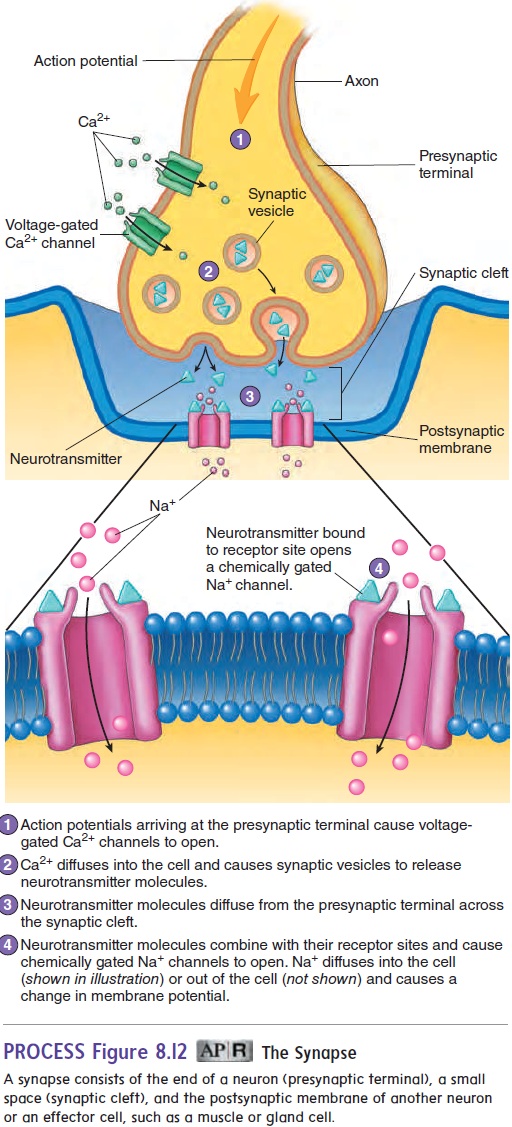Chapter: Essentials of Anatomy and Physiology: Nervous System
The Synapse - Electrical Signals and Neural Pathways

The Synapse
A synapse (sin′ aps) is a junction where the axon of one neuron interacts with another neuron or with cells of an effector organ, such as a muscle or gland (figure 8.12). The end of the axon forms a pre-synaptic terminal. The membrane of the dendrite or effector cell isthe postsynaptic membrane, and the space separating the presyn-aptic and postsynaptic membranes is the synaptic cleft. Chemical substances calledneurotransmitters (noor′ ō-trans-mit′ erz; neuro-, nerve + transmitto, to send across) are stored in synaptic vesicles in the presynaptic terminal. When an action potential reaches the presynaptic terminal, voltage-gated Ca2+ channels open, and Ca2+ moves into the cell. This influx of Ca2+ causes the release of neurotransmitters by exocytosis from the presynaptic terminal. The neurotransmitters diffuse across the synaptic cleft and bind to specific receptor molecules on the postsynaptic membrane. The binding of neurotransmitters to these membrane receptors causes chemically gated channels for Na+, K+, or Cl− to open or close in the postsynaptic membrane, depending on the type of neurotrans-mitter in the presynaptic terminal and the type of receptors on the postsynaptic membrane. The response may be either stimulation or inhibition of an action potential in the postsynaptic cell. For example, if Na+ channels open, the postsynaptic cell becomes depo-larized, and an action potential will result if threshold is reached. If K+ or Cl−channels open, the inside of the postsynaptic cell tends to become more negative, or hyperpolarized (hı̄′ per-pō′ lăr-ı̄-zed), and an action potential is inhibited from occurring.

Of the many neurotransmitters or suspected neurotransmitter substances, the best known are acetylcholine (ACh) (as′ e-til-kō′ lēn) and norepinephrine (nōr′ ep-i-nef′ rin). Other neurotrans-mitters include serotonin (sēr- ō-tō′ nin), dopamine (dō′ pă-mēn), γ (gamma)-aminobutyric (gam′ă ă-mē′nō-bū-tēr′ik) acid (GABA),glycine, and endorphins (en′ dōr-finz; endogenous morphine) (table 8.2). Neurotransmitter substances are rapidly broken down by enzymes within the synaptic cleft or are transported back into the presynaptic terminal. Consequently, they are removed from the synaptic cleft, so their effects on the postsynaptic membrane are very short-term. In synapses where acetylcholine is the neurotrans-mitter, such as in the neuromuscular junction , an enzyme called acetylcholinesterase (as′ e-til-kō-lin-es′ - ter-ās) breaks down the acetylcholine. The breakdown products are then returned to the presynaptic terminal for reuse. Norepinephrine is

either actively transported back into the presynaptic terminal or broken down by enzymes. The release and breakdown or removal of neurotransmitters occurs so rapidly that a postsynaptic cell can be stimulated many times a second. Drugs can modulate the action of neurotransmitters at the synapse. Cocaine and amphetamines increase the release and block the reuptake of norepinephrine, resulting in overstimulation of postsynaptic neurons and deleteri-ous effects on the body. Drugs that block serotonin reuptake are particularly effective at treating depression and behavioral disorders.
Related Topics